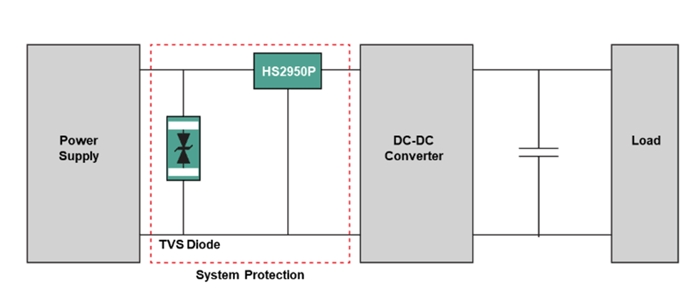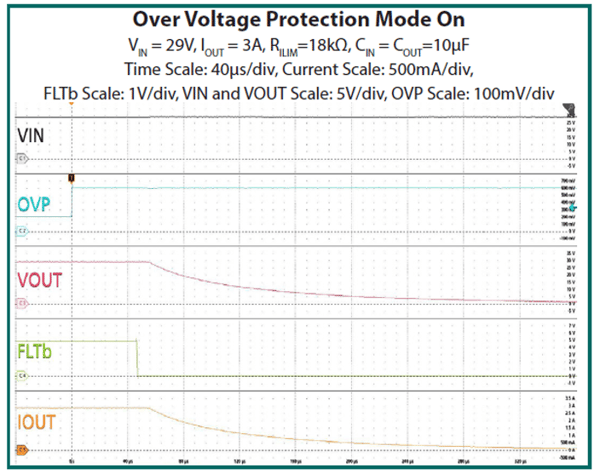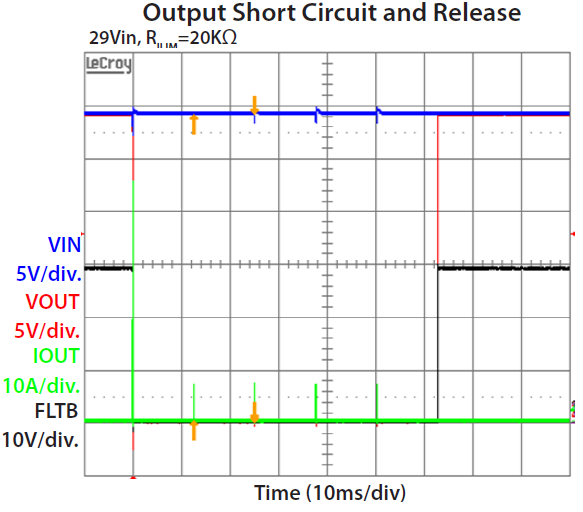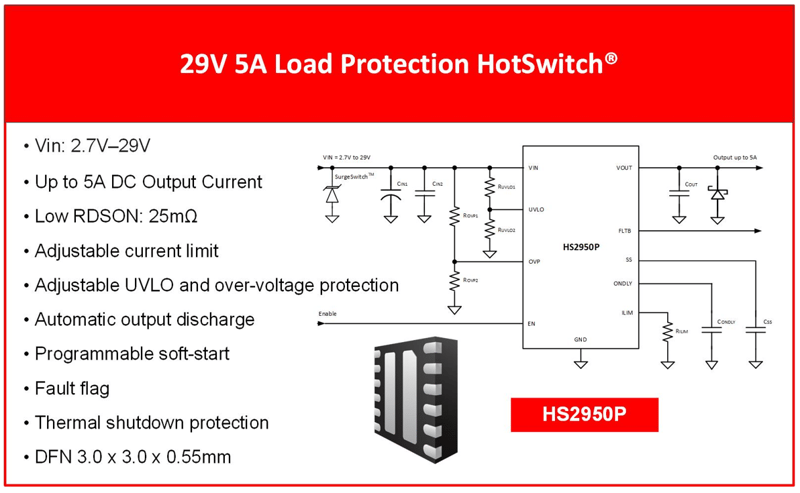HotSwitch® – 次のデザインを実現するeヒューズ
.jpg?width=600&height=314&name=semtech-blog-hotswitch%20(1).jpg)
HotSwitch®は、典型的な電気的過渡現象や定常状態の障害状態から電子システムを保護する統合型ロードスイッチまたはヒューズを備えたSemtechのデバイスの新しい製品ラインです。HotSwitchデバイスは主に、必要に応じて電源レールへの電流をオンまたはオフにします。電気サージを検出し、負荷を電源から切断することで下流のサブシステムを保護します。同時に、SemtechのHotSwitchポートフォリオのデバイスは、突入電流、過電圧、不足電圧、逆電流、短絡、過熱障害に対する保護を強化します。図1は、HotSwitchデバイスによってシステムがどのように保護されるかを示しています。
 Figure 1. System protection with a HotSwitch device
Figure 1. System protection with a HotSwitch device
Modern-day power electronic devices are designed to be smaller, more innovative and more efficient. Being power efficient means consuming power only when needed by the system. For a portable battery-powered device, saving power means longer battery life. But in recent years, power saving has become crucial for any electronic device, whether it is battery-powered or not. For an electronic gadget, not all circuitry needs to be active all the time. These circuits can consume power even in sleep mode. A load switch can automatically turn off and turn on a load as needed, significantly reducing overall power consumption. Multiple power sources are used in some applications, such as microprocessors, FPGAs, network switches, or industrial controllers. To ensure turn on and turn off happens appropriately, a specific order needs to follow in distributing power in the circuit. This ordering called power sequencing is done by load switches. Turning the load on and off and power sequencing are not the only functions carried out by a load switch. It also protects the load from a power supply in abnormal power situations such as inrush current and electrical transients.
Along with inrush current control, a load switch protects the electrical circuit from overvoltage, undervoltage, over-temperature, short-to-the-battery, and short-to-ground conditions. Due to all these protection features, the load switch is also called an electronic fuse or eFuse. An eFuse can replace a fragile conventional fuse and integrate all the protection features into one product. Semtech recently released an eFuse product, HotSwitch HS2950P. It is a single-channel integrated eFuse with a wide input voltage range of 2.7V to 29V, supporting up to 5A output current and a low 25mΩ (typical) Rds(on). Bundled in a tiny 3x3mm 12-pin DFN package, HotSwitch HS2950P also includes various adjustable protection features, including soft-start, turn-on-delay, overvoltage, undervoltage, and overcurrent limit.
 Figure 2. System protection with Semtech’s HS2950P
Figure 2. System protection with Semtech’s HS2950P
Functioning of HotSwitch
HotSwitch incorporates several advanced features desirable by a circuit designer. The main element in a HotSwitch device is an N-channel MOSFET which is used as a switch. The MOSFET is a voltage-controlled device. The MOSFET can be turned on or off by controlling the gate to source voltage. In specific scenarios, the MOSFET may need to operate at a voltage near the lower limit of the operating voltage range. A charge pump circuit is used to boost the gate voltage to the proper level to drive the N-channel MOSFET. The MOSFET connects the input line to the output interface. Let's review the basic features of a HotSwitch device shown in Figure 3.
 Figure 3. Basic features of HS2950P
Figure 3. Basic features of HS2950P
Inrush Current Control
A substantial current spike can flow into the uncharged output capacitors when the load switch turns on. This is known as the inrush current. Due to this vast spike, the current can exceed the absolute maximum ratings of the circuit components and eventually damage them. Also, the voltage in the circuit may be dropped to cater to the current spike demand. If the voltage drops below the required specification, the circuit may fail to turn on. So, it is not a good idea to turn on the switch instantly; instead, turn it on gently by limiting the inrush current. This is known as adjustable soft-start or slew-rate control and is implemented in HS2950P. The inrush current can be written by the equation, I=C(dV/dt), where I represents the inrush current, C is the total circuit capacitance being charged and dV/dt is the rate of change of voltage. We can notice in the equation that for a fixed capacitance, the inrush current control depends on dV/dt. More specifically, inrush current is inversely proportional to the change in time. The inrush current can be regulated by controlling the time. HS2950P uses an external capacitor CSS (Figure 3) to lengthen the soft-start time to control the inrush current.
Overcurrent Protection
Overcurrent protection (OCP) is a feature to limit the load current in an unusual situation when the load changes abruptly. This feature reduces the risk of potential damage to the circuit. When an overcurrent condition occurs, the HS2950P limits the load current to the threshold set by an external resistor, RILIM. RILIM is connected to the GND pin from the ILIM pin. The HotSwitch device operates as a current regulator during OCP to maintain the current flow at the allowable range. The OCP threshold of HS2950P ranges from 0.5A to 6.5A, set by RILIM. Figure 4 Shows the overcurrent response of HS2950P. During an OCP event, the FLTB signals a fault condition. Once the part enters into OCP event with IOCP=7A, it goes into a 200ms hiccup mode after a 0.5ms blanking time. When FLTB goes high, the part goes back to normal operation.
 Figure 4. Overcurrent response of HS2950P
Figure 4. Overcurrent response of HS2950P
Overvoltage and Undervoltage Protection
A HotSwitch device guards the electrical circuit against overvoltage and undervoltage by turning off the MOSFET. It features adjustable overvoltage protection (OVP) and undervoltage lock-out (UVLO) thresholds using an external programming resistor network. If the input voltage exceeds the overvoltage threshold, the HS2950P turns off the switch and prevents start-up.
The HotSwitch device also turns off the internal MOSFET and disconnects the load from the supply if the input voltage drops below the UVLO threshold. The undervoltage condition can malfunction the internal circuitry by partially turning the MOSFET on/off or sending incorrect signals to the control circuit. If the OVP or UVLO pin of HS2950P is connected to the ground, a default position for OVP (3.8V typical) and UVLO (2.6V typical) is set internally. Figure 5 shows that when the voltage on the OVP pin exceeds the 600mV threshold, the HotSwitch device turns off the MOSFET and the output voltage goes down to zero. The switch remains off as long as the voltage on OVP pin exceeds the 600mV threshold.
 Figure 5. Overvoltage response of HS2950P
Figure 5. Overvoltage response of HS2950P
Output Short Circuit Protection
Short circuit protection safeguards the circuit when the output terminal (Vout) is shorted to the ground, and a vast current flows rapidly through the switch. Whenever HS2950P determines a short-circuit condition, it turns off the internal switch. The device automatically attempts to restart immediately after the turn-off. If the short circuit persists, the device regulates the output load current to the current limit level and enters into a 200ms hiccup mode (Figure 6). If there is no abnormality, the HS2950P starts to operate normally.
 Figure 6. Short circuit protection on HS2950P
Figure 6. Short circuit protection on HS2950P
Thermal Shutdown Protection
HotSwitch devices feature thermal shutdown protection to prevent the circuit from overheating. The HotSwitch devices turn off and assert a fault flag when detecting the junction temperature above a specific limit. HS2950P declares a fault flag when the junction temperature above 150 degrees Celsius is detected. Once thermal shutdown happens, the device enters a 200ms hiccup mode without blanking time. The part remains in 200ms hiccup mode until the junction temperature cools down by 30 degrees Celsius.
Automatic Output Discharge
When a HotSwitch device turns off after a fault condition, the outside voltage does not go to zero immediately. Depending on the load and the output capacitance, it may take some time for the output voltage to go down to zero gradually. But modern electronics demand a complete turn-on and turn-off instantaneously. HS2950P has a feature called automatic output discharge for immediate turn-off. When the switch turns off, a discharge circuit sends all the stored charge to the ground.
 Figure 7. Features and schematic of HS2950P
Figure 7. Features and schematic of HS2950P
Conclusion
As electronic waste, or e-waste, is the fastest growing source of waste globally, as the potential amount of e-waste serves as an ongoing challenge for technology manufacturers. Semtech's HotSwitch products can fulfill protection needs, safeguarding electric systems and provides protection features that are able to prolong the life span of electronic devices as well as potentially reduce e-waste. Additionally, HotSwitch is able to meet multiple requirements, including inrush current, overvoltage, undervoltage, thermal protection requirements, quick output discharge, and short-circuit protection. The newly released HotSwitch product HS2950 (Figure 7) integrates all these protection features into one single small footprint 3x3mm 12-pin DFN package. Whether you need an automatic on-off switch, a power sequencing switch or an eFuse for protecting the circuit against transient and steady-state fault conditions, HotSwitch is the answer. Semtech's HotSwitch products offer thermal shutdown functionality and faults flagging to ensure a rugged defense for downstream industrial, telecom and consumer systems subject to transients and short circuits risk.
Visit the website to learn more.
Semtech®, the Semtech logo, and HotSwitch® are registered trademarks or service marks of Semtech Corporation or its affiliates. Other product or service names mentioned herein may be the trademarks of their respective owners.
